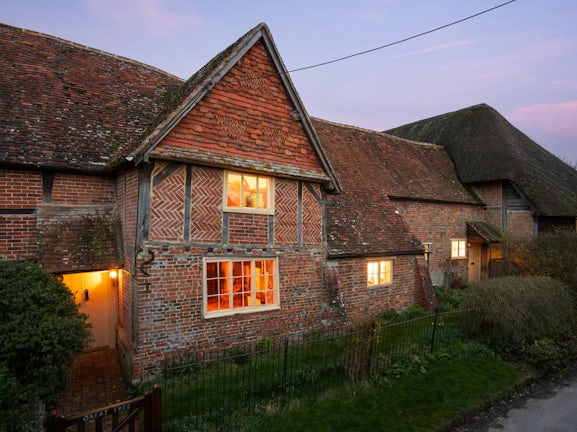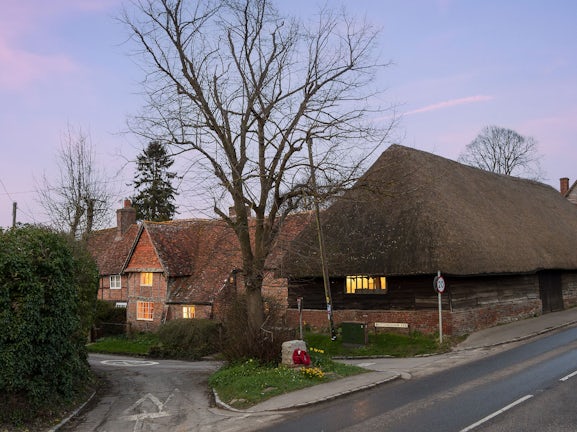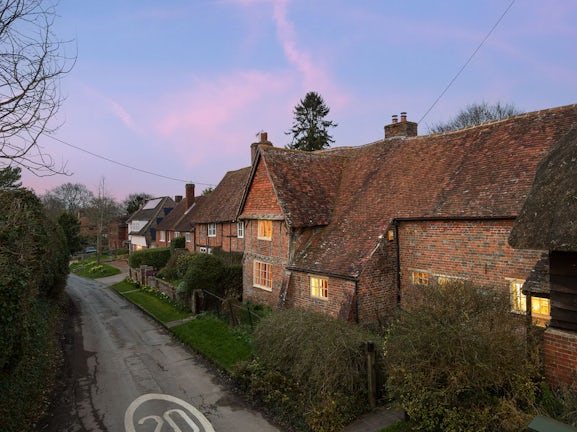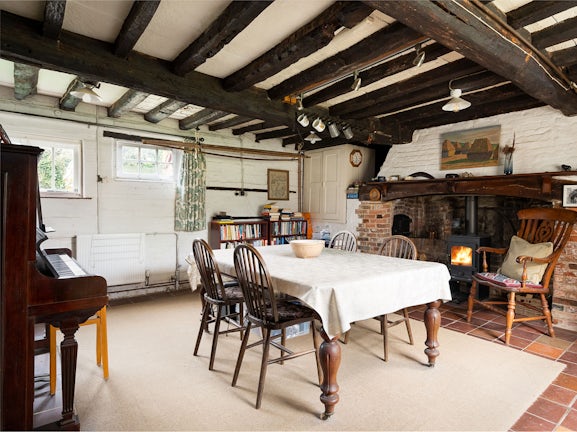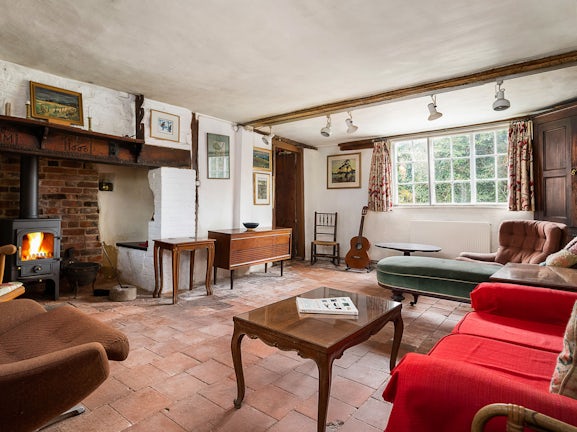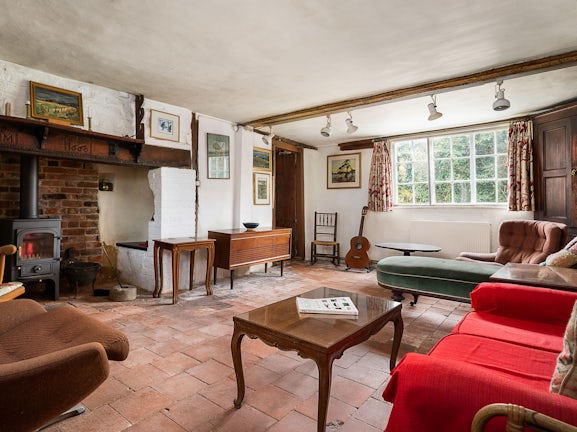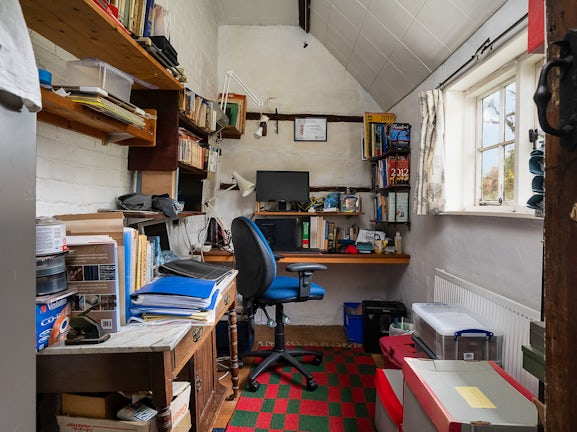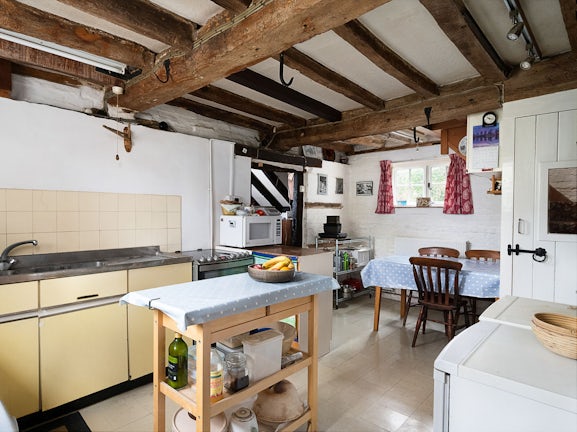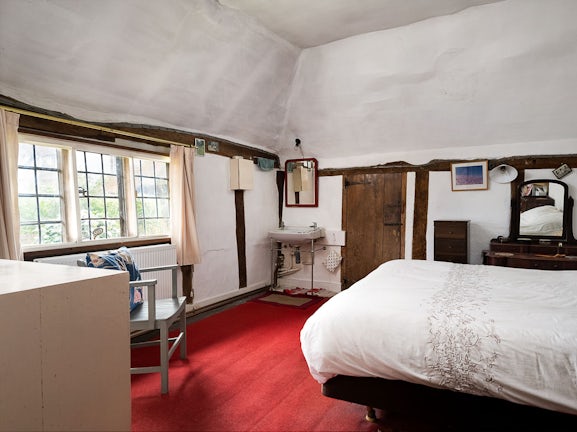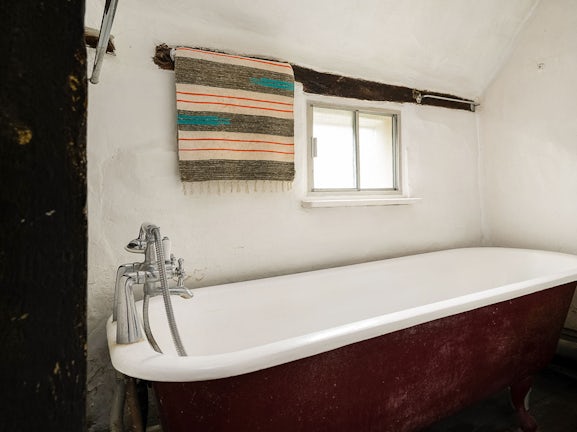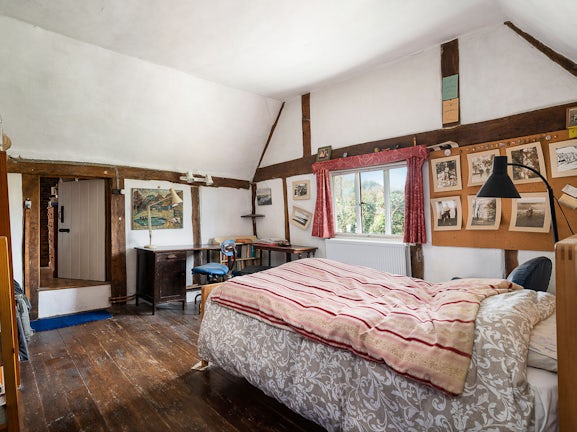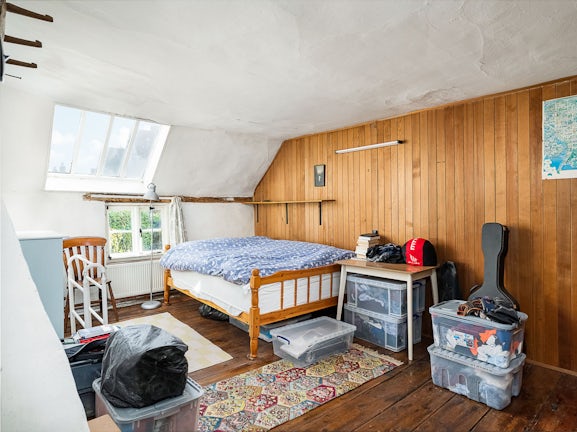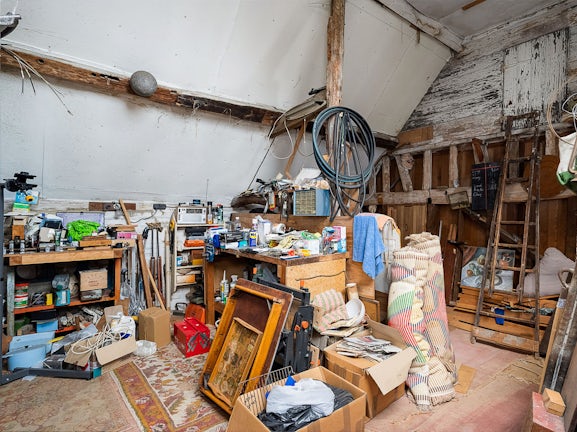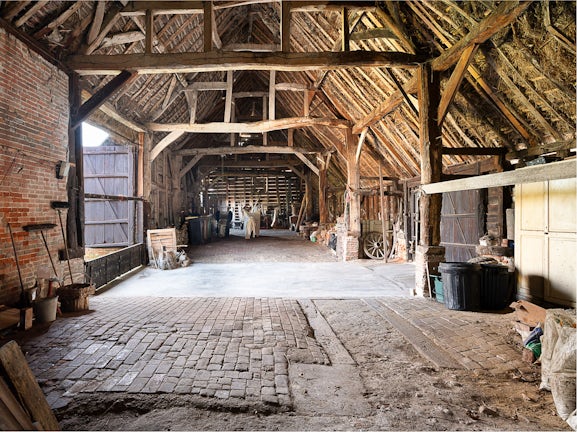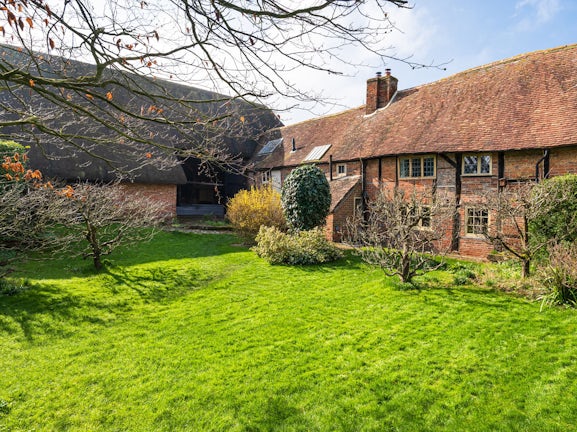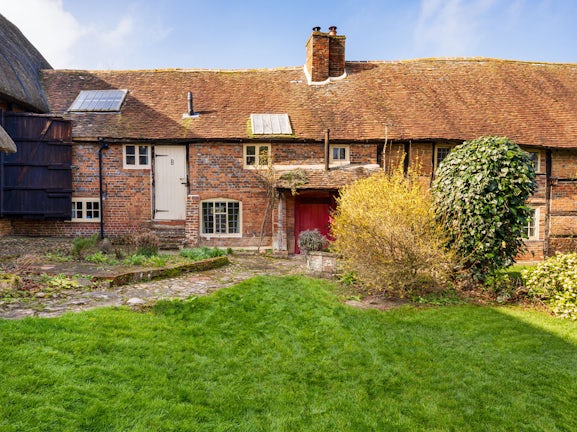Semi-detached House for sale on Nottingham Fee Didcot,
OX11
An extraordinary former farmhouse with a barn and walled garden in the centre of the village.
“Soon the swallows will arrive to nest in the barn.”
- 27-35 London Road,
Newbury, RG14 1JL - Sales & Lettings 01635 897822
Features
- Former farmhouse
- Enclosed gardens
- 25+m barn
- Short walk to pub
- Council Tax Band: G
Description
Tenure: Freehold
An extraordinary former farmhouse with a barn and walled garden in the centre of the village.
“Soon the swallows will arrive to nest in the barn.”
Situation
At the top of Nottingham Fee, a gentle ramble along the lane to or from the Red Lion, you’ll find Great Tree, an iconic building at the heart of a fantastically pretty, quintessentially English village.
Property
Once through the magnificent barn and within the walled garden is the beautiful, historic Grade II-listed Great Tree, a former working farmhouse, artists’ residence and very much-loved family home.
“The only way to really appreciate this house is to see it.”
Great Tree is the epitome of a rare opportunity. An extraordinary home with a rich history and a wealth of character beams, exposed brickwork and its very own barn. A charming home that is now ready for the next chapter in its long history.
“There’s a wealth of historical evidence of how a property changes over the centuries, how it retains its character and shows you how it’s retained its relevance.”
It’s the perfect, authentically aged canvas, ready to be sensitively updated for many more vibrant, relaxing, entertaining and memorable years of life.
Centuries of history
A home farm and family home for nearly 500 years, Great Tree sits on the site of an earlier smaller cottage, occupied at the time of the 1548 survey by Nicholas Ilbury, a member of one of the village’s oldest families.
Kitchen
As is often the way with farmhouses, you enter this family home through the kitchen, via the covered front porch with feature carved post.
Originally the dairy, the kitchen is rich in character with exposed and painted brickwork, the structural beams replete with strong metal meat hooks giving a nod to its former life.
“The meat hooks are so solid, you can lift yourself up on them.”
Today it’s a working kitchen diner, benefitting from windows looking to the front and rear of the house.
The glazed door opens onto stairs up to the Large Studio.
Dining room/family room
Through the dark-wood door with its wooden latch into the spacious, timber-ceilinged dining room.
“There’s an annual Ridgeway Walk, and one year my brother brought friends back here afterwards. More than 15 slept over, and ate around the dining table.”
Of the many original period features in this lovely large room, you have the stunning inglenook fireplace, once home to the kitchen range – you may be able to spot some of the old ironwork – now home to an efficient wood burning stove.
“The wood burner heats this end of the house. If you don’t want to put the heating on you can just light this.”
Look out for the old salt store to the right of the fireplace, and the bread oven with a relief image on the door to the left of the fireplace. Further left is a large white cupboard.
“I believe years ago people would bring their bread to be baked here”
From the beamed ceiling, still high enough for full-sized people, mugs hang from an old hay rake. Nods to its history and former lives punctuate this wonderful family home.
Entrance lobby
From the dining room you enter a small entrance lobby with ample storage for boots and coats.
The double doors, now united, lead out to a tiled porch with an elegant carved post, and the garden beyond.
“The carved post is from a four-poster bed, there’s another on the front porch. Another family in the village has the other two posts in their home."
Cloakroom
The compact cloakroom has a toilet with low-level cistern and hand basin.
Sitting room
From the short corridor with traditional clay tiles, you enter the sitting room.
Another inglenook fireplace greets you, with seats on either side and a mantlepiece carved with the date 1660 and the initials ENM, after previous owners Nicholas and Mary Ilbury (perhaps spelt Elbury).
“As a child I’d sit in the Inglenook with my brother, listening to the adults talk.”
Beneath the mantlepiece, a wood burning stove keeps you cosy and warm on cold winter nights.
Looking back to the door, you’ll see the rich dark wood panelling, believed to have come from Blewbury church.
Office / study
Off the sitting room, this studious space looks onto the quiet street and is nicely tucked away to be as distraction-free as possible.
Of note in this room, the painted herringbone brickwork and timbers.
Hallway
Beyond the sitting room is the hallway, an easily overlooked space, but one where it’s more evident than ever that you’re walking in the footsteps of centuries of residents and visitors.
You can even feel the impression workers’ hobnail boots made on the old clay tiles. Look down beneath the hallway window and you’ll notice a step, this was once a door that took the farmworkers directly into the farmyard.
“The house is redolent with history. Everywhere you look there’s something to see.”
The hallway stairs take you up to the master and second bedrooms.
UPSTAIRS
The upstairs hallway gives you a real sense of the quality of this house. From the solid beams to the wide floorboards and thick lath and plaster walls, no expense was spared when this house was built and later extended.
Master bedroom
The arched timber lintel above the door denotes the entrance to this super spacious bedroom. The wide window looks out onto the walled garden and catches the morning sun.
En suite
The en suite bathroom has an original ball and claw cast iron bath, with a low-level cistern toilet, and sits beneath a high vaulted ceiling with characteristic exposed timbers.
Bedroom two
The large second bedroom looks out over front of the house and captures the evening light.
This room has a very pleasing symmetry, the vaulted ceiling and timbers beautifully framing the window. This is complemented by the wide solid wood floorboards.
Through a short door and a step up is a space that has been put to good use as a darkroom, and which could be used for storage or as a delightful play space.
Storage
Opposite the master bedroom is a walk-in storage cupboard, while on the hallway are the double doors to a linen closet.
Bedroom three / Small Studio
A beautifully light, bright double bedroom, or Small studio as it’s also known, with views of the sky and surrounding trees as well as the garden below.
The wooden wall, erected in the early 1960s, is Canadian cedar. The two ‘hidden’ doors lead into a storage/wardrobe space and the ‘Large Studio’ next door.
“This end of the house, with the Large Studio, can be used as a self-contained guest wing. You could easily co-exist without disturbing each other.”
Large Studio / workshop / bedroom 4
This incredibly light, bright super-high-ceilinged space was once the studio of renowned artist and sculptor, Clara Billing.
Used today as a storage and workshop space, it could be reimagined into an incredible master bedroom suite.
“We built a canoe in here in the end of the 60s.”
The Large Studio can be approached in three ways: from the kitchen via the back stairs, through the ‘hidden door’ in the Small Studio/bedroom three, and potentially through the ‘B’ door into the garden.
A small, elevated doorway takes you into the attic, which runs the length of the house.
Outside
To the front of the house is a pretty front garden, with iron railings and gates to paths that lead to each of the front doors, the one into the kitchen being the most often used.
On the other side of the house, the garden is fully enclosed, being bounded by the house, barn and lovely old brick walls.
A cobbled path, with embedded millstone, leads you from the house into the garden. Here you have an old well, filled in now but which may be capable of restoration if you want your own water source.
You can pick your own fruit from the apricot, apple and pear trees, perfect for delicious Autumnal cobblers and crumbles.
And you have the star of the show: the fabulous timber-framed barn.
The barn
Exceptional in a village centre location, the iconic and much-loved thatched barn.
At more than 25 meters by 7.8 meters, the barn is large enough to store several cars, host theatrical productions or, with a bit of vision and the required consents, be given an entirely new lease of life.
“We’ve used the barn for all sorts of things over the years. For repairing cars and motorbikes. Somewhere dry to ride our motorbikes. Table tennis matches. Exhibitions – there's a Blewbury festival every two years or so. Storing farm implements. Even practising our climbing and abseiling, with ropes thrown over the beams.”
“We think the middle concrete section is a former cart pit that’s been filled in – the wooden beams are the same width as a cart axle”
You’ll notice the differently sized barn doors. This is because the huge doors that open into the garden were used by waggons loaded high with the harvest, to be unloaded onto the threshing floor.
The barn doors have a deliberate gap which allows the wind to take out the chaff after threshing.
Once unladen, the waggons would exit through the smaller doors (now being shorter in height themselves) onto the street outside.
“Swallows arrive to nest in the spring and summer. It’s a joy to see, hear, and give a home to another aspect of life in the barn.”
The old pump from the indoor capped well can be seen leaning against one of the barn pillars.
Herringbone brickwork give another reminder that when the house was built, the owners wanted nothing but the best.
Cowshed
To one side of the barn is the ‘cowshed’ as it’s known by the current owner. A pleasant, sheltered space with a good-sized workshop to one side.
“There’s no better to place to sit in the late morning than on the bench pulled out into the sunshine outside the old cowshed.
You can see the whole walled garden. It’s a very private garden. It’s lovely to sit and watch the butterflies and bees that visit the fruit trees.”
Situation
Nestling at the foot of the Berkshire Downs, part of the North Wessex Downs Area of Outstanding Natural Beauty, and overlooked by an Iron Age hill fort, Blewbury is a picture postcard village.
The wider area is laced with chalk streams that feed the Mill Brook, which in turn feeds the Thames at Wallingford.
If you like walking, you’re in the right place. You can:
- go up onto the Berkshire Downs to take in the glorious views as you walk the Ridgeway, the oldest road in Europe.
- head to Blewburton Hill to explore the Iron Age hill fort.
discover the barrows, burial mounds and Roman shrines that stud the area.
Community
Renowned for being a thriving community, you’re spoilt for choice with everything from the church and pubs, cafes, bakers to a plethora of social groups, sports and arts and crafts clubs.
“There’s a lot going on in Blewbury, and accessible from Blewbury.”
Look out for, amongst others:
- Blewbury Boxing Day walk
- Egg rolling at the chalkpits
- Duck race – organised by the bell ringers
- The croquet lawn – one of the best in England and where the national team have come to practice
- The Blewbury Players
- Community cinema
- Tennis, art, guitar, embroidery, choir and badminton groups
The list seems to be bigger than the village!
Transport links
Blewbury sits on the A417, or London Road, which runs through the village and connects with the A34.
By road, Didcot is just 4 miles away, Wantage 10 and Oxford 14.
By train, from Didcot Parkway, direct trains into London Paddington take from just 38 minutes. Other main destinations include Oxford, Bristol, Cheltenham and Cardiff.
Good to know
People who live in Blewbury, or who are from Blewbury, are known as Blewbarians.
Famous Blewbarians have included notable authors Dick Francis and Kenneth Grahame.
Schooling
Primary: Blewbury C of E Primary School, which is just at the end of the street.
Secondary: Didcot Girls’ School, The Downs School, Wallingford School, St Birinus School
In addition, there is a wide range of private schooling available, which includes Moulsford Prep School and Cranford House School in Wallingford, Pangbourne College, Abingdon School, Bradfield College, Radley College and more.
Services
Hot water and heating are mains gas fired.
Water is mains fed.
Broadband
According to Openreach, Superfast Fibre is available at up to 80Mbps with Ultrafast Full Fibre at up to 1000Mbps due to be built before Dec 2026.
According to Vodafone, their 4G service is ‘Good indoors and outdoors’.
Council
The local authority is Vale of White Horse.
The house is Council Tax band G.
Tenure
Freehold
EPC rating: D. Council tax band: G, Tenure: Freehold,
